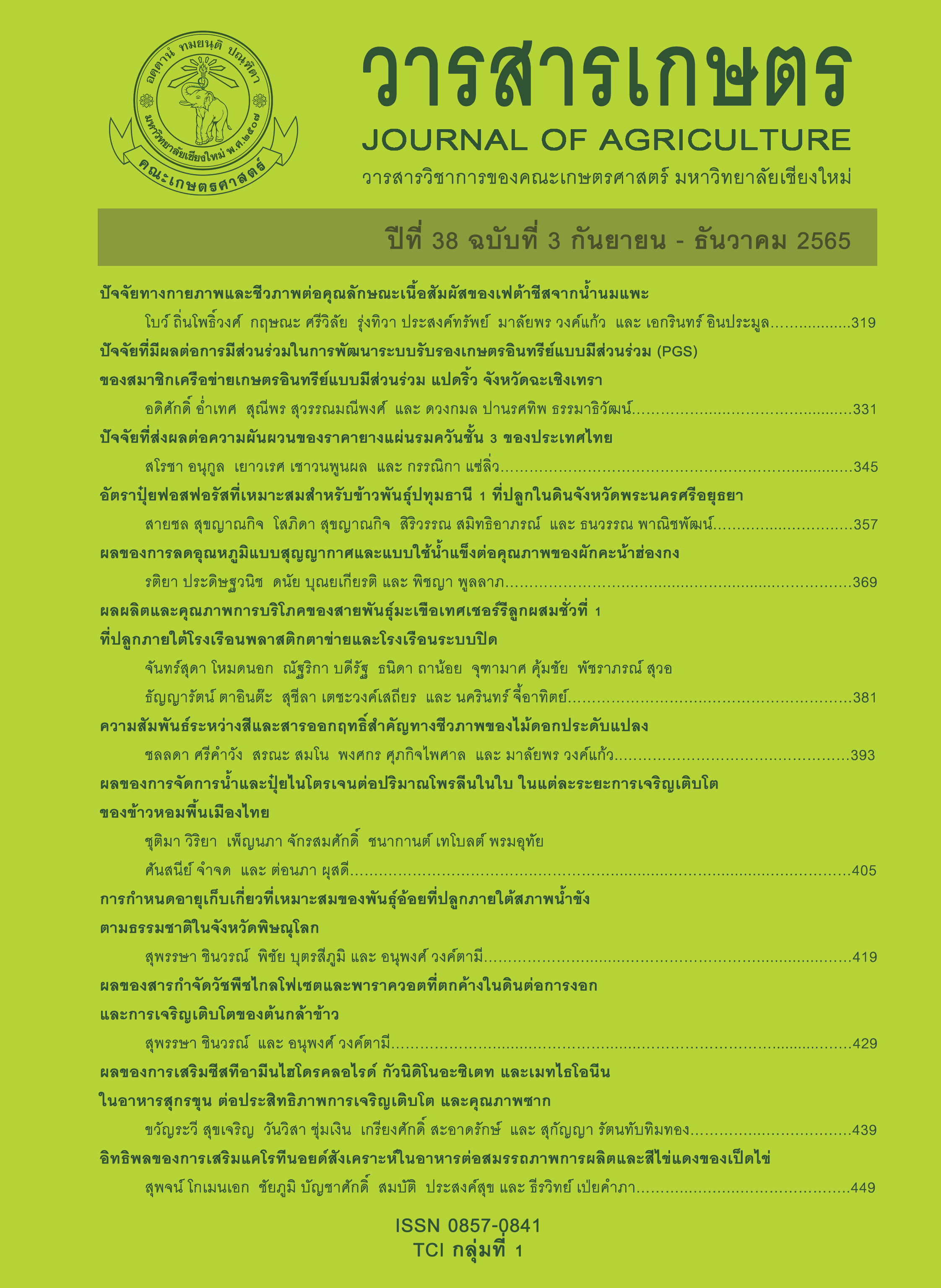ผลผลิตและคุณภาพการบริโภคของสายพันธุ์มะเขือเทศเชอร์รีลูกผสมชั่วที่ 1 ที่ปลูกภายใต้โรงเรือนพลาสติกตาข่ายและโรงเรือนระบบปิด
Main Article Content
บทคัดย่อ
สภาพอากาศที่เปลี่ยนแปลงไปทำให้มะเขือเทศเชอร์รีที่ผลิตในสภาพแปลงเปิดมีผลผลิตลดลงและคุณภาพไม่คงที่ การปรับปรุงพันธุ์พืชร่วมกับการพัฒนาระบบการผลิตสมัยใหม่อาจช่วยเพิ่มคุณภาพและผลผลิตของมะเขือเทศเชอร์รีได้ ดังนั้น งานวิจัยนี้จึงศึกษาผลผลิตและคุณภาพของมะเขือเทศเชอร์รีลูกผสมชั่วที่ 1 ภายใต้สภาพโรงเรือนที่แตกต่างกัน โดยงานทดลองนี้ทำการปลูกทดสอบมะเขือเทศเชอร์รีลูกผสมทั้งหมด 3 คู่ผสม ร่วมกับสายพันธุ์พ่อจำนวน 3 สายพันธุ์ (102, 103 และ 104) และสายพันธุ์แม่จำนวน 2 สายพันธุ์ (201 และ 202) ภายใต้สภาพโรงเรือนพลาสติกตาข่ายและโรงเรือนระบบปิด ในฤดูแล้ง ระหว่างเดือนพฤศจิกายน 2563 ถึงมีนาคม 2564 แต่ละสภาพแวดล้อมวางแผนการทดลองแบบสุ่มสมบูรณ์ภายในบล็อก (RCBD) จำนวน 3 ซ้ำ ผลการทดลองพบว่า อิทธิพลของพันธุ์ สภาพแวดล้อม และปฏิสัมพันธ์ระหว่างพันธุ์กับสภาพแวดล้อมมีผลต่อทุกลักษณะที่ศึกษา ยกเว้นปฏิสัมพันธ์ระหว่างพันธุ์กับสภาพแวดล้อม ซึ่งไม่มีผลต่อการสะสมปริมาณของแข็งทั้งหมดที่ละลายน้ำได้ อีกทั้งยังพบว่า โรงเรือนพลาสติกตาข่ายมีอุณหภูมิในอากาศสูงและความชื้นสัมพัทธ์ต่ำ ขณะที่โรงเรือนระบบปิดมีอุณหภูมิและความชื้นสัมพัทธ์ค่อนข้างคงที่และอยู่ในระดับที่เหมาะสม ซึ่งส่งผลให้มะเขือเทศเชอร์รีที่ปลูกในสภาพโรงเรือนระบบปิดมีน้ำหนักผลและผลผลิต (12.20 กรัม และ 704.0 กรัม ตามลำดับ) มากกว่ามะเขือเทศเชอร์รีที่ปลูกในสภาพโรงเรือนพลาสติกตาข่าย (10.33 กรัม และ 642.0 กรัม ตามลำดับ) ในทางตรงกันข้าม ผลมะเขือเทศเชอร์รีที่ปลูกในสภาพโรงเรือนพลาสติกตาข่ายมีการสะสมปริมาณของแข็งทั้งหมดที่ละลายน้ำได้ (10.8 เปอร์เซ็นต์) สูงกว่าผลมะเขือเทศเชอร์รีที่ปลูกในสภาพโรงเรือนระบบปิด (8.9 เปอร์เซ็นต์) นอกจากนี้พบว่า มะเขือเทศเชอร์รีลูกผสม 201 / 102, 202 / 103 และ 202 / 104 ให้ผลผลิตมากกว่าสายพันธุ์แม่ รวมทั้งมีการสะสมปริมาณของแข็งทั้งหมดที่ละลายน้ำได้สูงกว่าสายพันธุ์พ่อ ดังนั้น การผลิตมะเขือเทศเชอร์รีลูกผสมภายใต้โรงเรือนระบบปิดสามารถผลิตมะเขือเทศที่มีคุณภาพดีและให้ผลผลิตสูงได้
Article Details

อนุญาตภายใต้เงื่อนไข Creative Commons Attribution-NonCommercial-NoDerivatives 4.0 International License.
เอกสารอ้างอิง
Avdikos, I.D., R. Tagiakas, P. Tsouvaltzis, I. Mylonas, I.N. Xynias and A.G. Mavromatis. 2021. Comparative evaluation of tomato hybrids and inbred lines for fruit quality traits. Agronomy 11(3): 609, doi: 10.3390/agronomy11030609.
Beckles, D.M. 2012. Factors affecting the postharvest soluble solids and sugar content of tomato (Solanum lycopersicum L.) fruit. Postharvest Biology and Technology 63(1): 129-140.
Dutta, A.K., S. Akhtar, C. Karak and P. Hazra. 2013. Gene actions for fruit yield and quality characters of tomato through generation mean analysis. Indian Journal of Horticulture 70(2): 230-237.
El-Gabry, M.A.H., T.I.H. Solieman and A.I.A. Abido. 2014. Combining ability and heritability of some tomato (Solanum lycopersicum L.) cultivars. Scientia Horticulturae 167: 153-157.
Gill, N.S. and L. Kaur. 2019. Economics of cherry tomato (Solanum lycopersicum var. cerasiforme) cultivation. Journal of Pharmacognosy and Phytochemistry 8(6): 880-881.
Gomez, K.A. and A.A. Gomez. 1984. Statistical Procedures for Agricultural Research. 2nd ed. John Wiley and Sons, New York. 680 p.
Gurung, T., S. Techawongstien, B. Suriharn and S. Techawongstien. 2012. Stability analysis of yield and capsaicinoids content in chili (Capsicum spp.) grown across six environments. Euphytica 187: 11-18.
Harel, D., H. Fadida, A. Slepoy, S. Gantz and K. Shilo. 2014. The effect of mean daily temperature and relative humidity on pollen, fruit set and yield of tomato grown in commercial protected cultivation. Agronomy 4(1): 167-177.
Hasanuzzaman, M., K. Nahar, M.M. Alam, R. Roychowdhury and M. Fujita. 2013. Physiological, biochemical, and molecular mechanisms of heat stress tolerance in plants. International Journal of Molecular Sciences 14(5): 9643-9684.
Huang, Y., Y. Li and X. Wen. 2011. The effect of relative humidity on pollen vigor and fruit setting rate of greenhouse tomato under high temperature condition. Acta Agriculturae Boreali-occidentalis Sinica 20(11): 105-110.
Islam, M.R., S. Ahmad and M.M. Rahman. 2012. Heterosis and qualitative attributes in winter tomato (Solanum lycopersicum L.) hybrids. Bangladesh Journal of Agricultural Research 37(1): 39-48.
Jeeatid, N., B. Suriharn, S. Techawongstien, S. Chanthai, P.W. Bosland and S. Techawongstien. 2018. Evaluation of the effect of genotype-by-environment interaction on capsaicinoid production in hot pepper hybrids (Capsicum chinense Jacq.) under controlled environment. Scientia Horticulturae 235: 334-339.
Milutinovic, S. and Z. Djukic. 1997. Yield components and total yield of tomato sorts and hybrids. Acta Horticulturae 462: 633-636.
Panthee, D.R., C. Cao, S.J. Debenport, G.R. Rodríguez, J.A. Labate, L.D. Robertson, A.P. Breksa, E. van der Knaap and B.B.M. Gardener. 2012. Magnitude of genotype x environment interactions affecting tomato fruit quality. HortScience 47(6): 721-726.
Pratta, G., R. Zorzoli and L.A. Picardi. 2003. Diallel analysis of production traits among domestic, exotic and mutant germplasms of Lycopersicon. Genetics and Molecular Research 2(2): 206-213.
Ro, S., L. Chea, S. Ngoun, Z.P. Stewart, S. Roeurn, P. Theam, S. Lim, R. Sor, M. Kosal, M. Roeun, K.S. Dy and P.V.V. Prasad. 2021. Response of tomato genotypes under different high temperatures in field and greenhouse conditions. Plants 10(3): 449, doi: 10.3390/plants10030449.
Sato, S., M.M. Peet and J.F. Thomas 2000. Physiological factors limit fruit set of tomato (Lycopersicon esculentum Mill.) under chronic, mild heat stress. Plant, Cell & Environment 23(7): 719-726.
Sato, S., M.M. Peet and J.F. Thomas. 2002. Determining critical pre- and post-anthesis periods and physiological processes in Lycopersicon esculentum Mill. exposed to moderately elevated temperatures. Journal of Experimental Botany 53(371): 1187-1195.
Sekara, A., P. Pokluda, E. Cozzolino, L. del Piano, A. Cuciniello and G. Caruso. 2019. Plant growth, yield, and fruit quality of tomato affected by biodegradable and non-degradable mulches. Horticultural Science 46(3): 138-145.
Shalaby, T.A. 2013. Mode of gene action, heterosis and inbreeding depression for yield and its components in tomato (Solanum lycopersicum L.). Scientia Horticulturae 164: 540-543.
Shivashankara, K.S., K.C. Pavithra, R.H. Laxman, A.T. Sadashiva, T.K. Roy and G.A. Geetha. 2015. Changes in fruit quality and carotenoid profile in tomato (Solanum lycopersicon L.) genotypes under elevated temperature. Journal of Horticultural Sciences 10(1): 38-43.
Sinesio, F., M. Cammareri, V. Cottet, L. Fontanet, M. Jost, E. Moneta, S. Moneta, M. Peparaio, R.R. del Castillo, E.S. Civitelli, P. Spigno, A. Vitiello, B. Navez, J. Casals, M. Causse, A. Granel and S. Grandillo. 2021. Sensory traits and consumer’s perceived quality of traditional and modern fresh market tomato varieties: a study in three european countries. Foods 10(11): 2521, doi: 10.3390/foods10112521.
Singh, R., S. Singh, D.S. Cheema and M.S. Dhaliwal. 2005. Screening for heat tolerance in tomato (Solanum lycopersicum L.). Vegetable Science 32(1): 90-91.
Sirisathaworn, S., P. Chulaka, P. Kaewsorn and I. Pusittigul. 2016. Effects of foliar salicylic acid on yield and quality of tomato (Lycopersicon esculentum Mill.) growing under short-term water deficit. Agricultural Science Journal 47(Suppl. 2): 545-548. (in Thai)
Susic, Z., N. Pavlovic, D. Cvikic and T. Sretenovic-Rajicic. 2002. Studies of correlation between yield and fruit characteristics of (Lycopersicon esculentum Mill.) hybrids and their parental genotypes. Acta Horticulturae 579: 163-166.
Tinyane, P.P., D. Sivakumar and P. Soundy. 2013. Influence of photo-selective netting on fruit quality parameters and bioactive compounds in selected tomato cultivars. Scientia Horticulturae 161: 340-349.
Xu, H.L., D. Iraqi and A. Gosselin. 2007. Effect of ambient humidity on physiological activities and fruit yield and quality of greenhouse tomato. Acta Horticulturae 761: 85-92.


